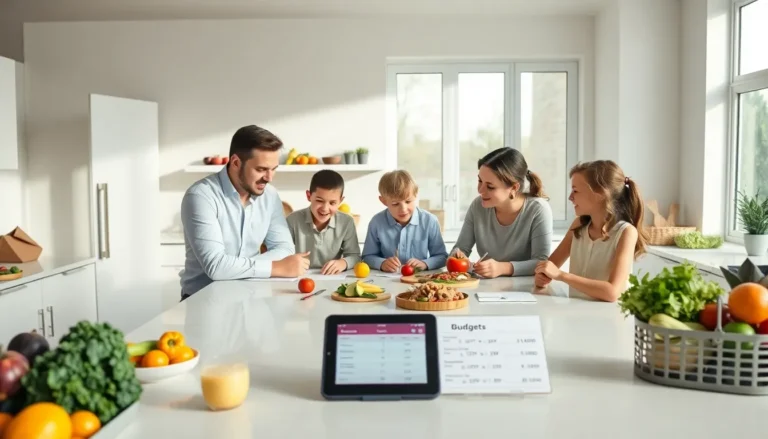Table of Contents
ToggleIn a world where teenagers seem to be glued to their screens, it’s hard to imagine life without technology. Whether they’re texting friends, streaming the latest shows, or conquering video game worlds, technology is their playground. But what happens when this digital wonderland becomes a double-edged sword?
Overview Of Teenagers And Technology
Technology significantly shapes the daily lives of teenagers. It acts as a primary means of communication, allowing them to connect through texting and social media platforms. Streaming services provide entertainment, offering access to a vast array of movies, series, and music. Gaming provides another avenue for interaction and engagement, often fostering friendships among peers.
Devices like smartphones and tablets dominate their landscape. Research indicates that over 95% of teenagers own smartphones, making these devices essential for navigation in their social and academic worlds. Online learning tools have also become crucial, particularly during transitions to remote education.
Screen time raises questions about health implications. Experts highlight concerns about mental health, linking excessive use to anxiety, depression, and disrupted sleep patterns. Yet, technology also has the potential to promote positive outcomes, enhancing educational resources and encouraging creativity.
Teenagers increasingly leverage technology for personal expression. Platforms like Instagram and TikTok enable them to showcase talents and connect with broader audiences. These tools often support movements for social change, giving teens a voice.
Balancing technology use remains an ongoing challenge. Parents and educators emphasize the importance of setting boundaries to promote healthy habits. By understanding both the advantages and drawbacks, stakeholders can guide teens toward a more balanced relationship with technology.
Impact On Social Skills

Technology significantly alters how teenagers engage with one another. Texting often replaces face-to-face conversations, leading to a decline in verbal communication skills. Many young people express preference for online interactions due to perceived lower social anxiety, yet this can hinder the development of important social skills like empathy and active listening. In moderation, it encourages convenient communication, allowing for quick connections.
Communication Changes
Changes in communication styles become evident with increased technology use. Teenagers often gravitate toward abbreviations and emojis to convey emotions. This shift fosters creativity but can also lead to miscommunication without visual cues. Studies indicate that digital conversations lack the depth of personal exchanges, resulting in superficial connections. Adaptability remains crucial as teens navigate both digital and in-person interactions, balancing convenience with substance.
Relationship Dynamics
Relationships shift as technology influences social interactions. Online platforms allow teens to form friendships based on shared interests, often leading to broader social circles. Increased connectivity can improve support networks, yet it may contribute to isolation if online interactions replace in-person experiences. Conflicts can escalate quickly online due to anonymity, making resolution more challenging. Maintaining healthy relationships necessitates effective management of both online and offline communication strategies.
Educational Benefits
Technology offers substantial educational benefits to teenagers. Digital platforms enhance learning opportunities through interactive tools and applications.
Enhanced Learning Tools
Interactive learning tools provide engaging experiences that cater to various learning styles. Apps like Khan Academy and Duolingo deliver personalized learning experiences, making studying more efficient. Online simulations and educational games help solidify concepts in subjects such as science and mathematics. Virtual classrooms, utilized in remote learning, foster collaboration between students and teachers, facilitating real-time feedback. Emphasizing practical applications, technology encourages hands-on learning, which aids retention and understanding of complex material.
Access To Information
Instant access to information empowers teenagers to explore topics of interest. Online resources like educational websites and databases grant exposure to a wealth of knowledge beyond traditional textbooks. With the ability to conduct research from anywhere, students can engage in self-directed learning based on curiosity. Peer-reviewed journals and articles provide credible sources for academic work, enhancing the quality of their assignments. Bookmarking tools help organize information, streamlining the learning process and promoting effective study habits.
Risks And Challenges
Teenagers face several risks and challenges related to their use of technology, particularly in areas like cyberbullying and screen time addiction.
Cyberbullying
Cyberbullying poses a significant threat to teenagers, impacting their mental health. Approximately 37% of young people experience online bullying, leading to increased anxiety and depression. Online platforms provide anonymity, which can embolden bullies and escalate harassment. Parents and educators report that victims often feel helpless, and the lack of immediate support can worsen feelings of isolation. Many teens may hesitate to report incidents, fearing retaliation or shame. Understanding the signs of cyberbullying is essential for caregivers, as early intervention can mitigate long-term psychological effects. Encouraging open conversations about online interactions creates awareness and fosters a safer digital environment.
Screen Time Addiction
Screen time addiction affects productivity and well-being among teenagers, with nearly 50% spending over seven hours daily on devices. Excessive use often leads to sleep disturbances and decreased physical activity. Teenagers frequently prioritize their online lives over real-world connections, which can result in feelings of loneliness. Additionally, the pressure to stay connected can create stress, as teens constantly check notifications. Schools and parents must set guidelines to encourage healthier habits, like regular breaks from screens. Incorporating technology-free time into daily routines promotes balanced lifestyles while optimizing social and academic engagement. Recognizing the signs of addiction is vital in fostering a healthier relationship with technology.
Balancing Technology Use
Maintaining a healthy balance with technology is crucial for teenagers’ overall well-being. Establishing guidelines helps them use digital devices wisely.
Setting Boundaries
Boundaries around technology use promote healthier habits. Parents can set limits on screen time, such as restricting phone use during meals or designated study hours. Research indicates that over 50% of teenagers spend more than seven hours daily on devices, leading to potential addiction. Parents should encourage tech-free zones in their homes, creating spaces for family interaction and meaningful conversations. Regularly discussing technology use fosters awareness about potential negative effects, including anxiety or disrupted sleep. Encouragement from caregivers can motivate teenagers to self-regulate their device usage.
Encouraging Offline Activities
Encouraging offline activities helps teenagers develop essential life skills. Engaging in sports, arts, or community service presents opportunities for social interaction beyond screens. Studies show that physical activities reduce screen time and enhance mental health. Parents can promote hobbies that interest their teenagers, ensuring they explore diverse experiences. Vacationing or weekend outings away from technology adds excitement and fosters family bonding. Organizing family game nights or outdoor activities creates a foundation for lasting memories. Pursuing offline engagements helps teenagers build relationships and navigate the world effectively.
Navigating the complex relationship between teenagers and technology is crucial for their development. While technology offers unparalleled opportunities for learning and connection, it also presents significant challenges that can impact mental health and social skills. Striking a balance is essential to ensure that teens can harness the benefits of digital tools while minimizing potential drawbacks. Encouraging offline activities and fostering open communication about technology use can help create a healthier environment. By promoting thoughtful engagement with technology, caregivers can support teenagers in building meaningful relationships and developing essential life skills in an increasingly digital world.





